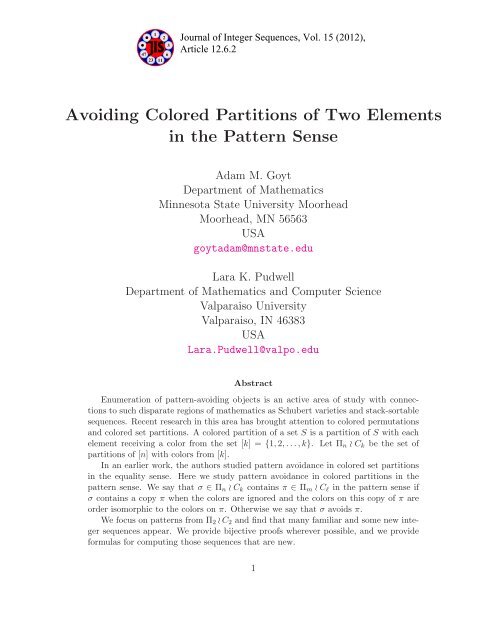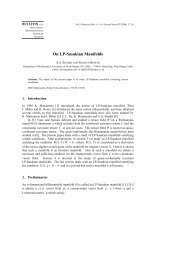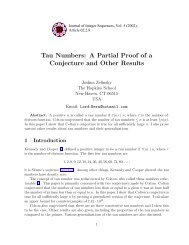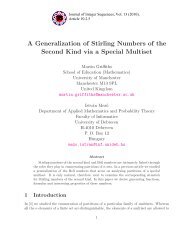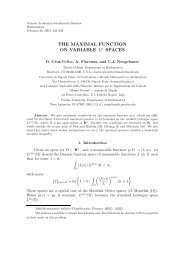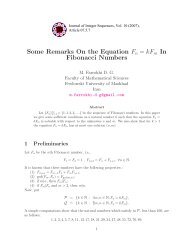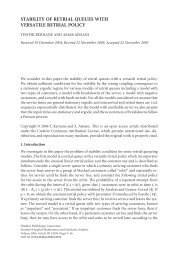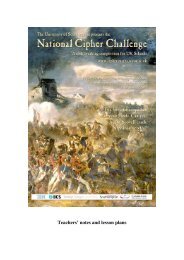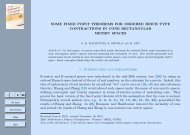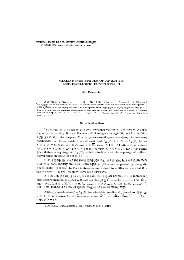Avoiding Colored Partitions of Two Elements in the Pattern Sense
Avoiding Colored Partitions of Two Elements in the Pattern Sense
Avoiding Colored Partitions of Two Elements in the Pattern Sense
You also want an ePaper? Increase the reach of your titles
YUMPU automatically turns print PDFs into web optimized ePapers that Google loves.
12347 623 11Journal <strong>of</strong> Integer Sequences, Vol. 15 (2012),Article 12.6.2<strong>Avoid<strong>in</strong>g</strong> <strong>Colored</strong> <strong>Partitions</strong> <strong>of</strong> <strong>Two</strong> <strong>Elements</strong><strong>in</strong> <strong>the</strong> <strong>Pattern</strong> <strong>Sense</strong>Adam M. GoytDepartment <strong>of</strong> Ma<strong>the</strong>maticsM<strong>in</strong>nesota State University MoorheadMoorhead, MN 56563USAgoytadam@mnstate.eduLara K. PudwellDepartment <strong>of</strong> Ma<strong>the</strong>matics and Computer ScienceValparaiso UniversityValparaiso, IN 46383USALara.Pudwell@valpo.eduAbstractEnumeration <strong>of</strong> pattern-avoid<strong>in</strong>g objects is an active area <strong>of</strong> study with connectionsto such disparate regions <strong>of</strong> ma<strong>the</strong>matics as Schubert varieties and stack-sortablesequences. Recent research <strong>in</strong> this area has brought attention to colored permutationsand colored set partitions. A colored partition <strong>of</strong> a set S is a partition <strong>of</strong> S with eachelement receiv<strong>in</strong>g a color from <strong>the</strong> set [k] = {1, 2, . . .,k}. Let Π n ≀ C k be <strong>the</strong> set <strong>of</strong>partitions <strong>of</strong> [n] with colors from [k].In an earlier work, <strong>the</strong> authors studied pattern avoidance <strong>in</strong> colored set partitions<strong>in</strong> <strong>the</strong> equality sense. Here we study pattern avoidance <strong>in</strong> colored partitions <strong>in</strong> <strong>the</strong>pattern sense. We say that σ ∈ Π n ≀ C k conta<strong>in</strong>s π ∈ Π m ≀ C l <strong>in</strong> <strong>the</strong> pattern sense ifσ conta<strong>in</strong>s a copy π when <strong>the</strong> colors are ignored and <strong>the</strong> colors on this copy <strong>of</strong> π areorder isomorphic to <strong>the</strong> colors on π. O<strong>the</strong>rwise we say that σ avoids π.We focus on patterns from Π 2 ≀ C 2 and f<strong>in</strong>d that many familiar and some new <strong>in</strong>tegersequences appear. We provide bijective pro<strong>of</strong>s wherever possible, and we provideformulas for comput<strong>in</strong>g those sequences that are new.1
1 IntroductionKnuth [8] first <strong>in</strong>troduced pattern avoidance <strong>in</strong> permutations, which cont<strong>in</strong>ues to be an activearea <strong>of</strong> research today. Given a str<strong>in</strong>g <strong>of</strong> <strong>in</strong>tegers s, <strong>the</strong> reduction <strong>of</strong> s, denoted red(s) is <strong>the</strong>unique str<strong>in</strong>g obta<strong>in</strong>ed by replac<strong>in</strong>g <strong>the</strong> ith smallest <strong>in</strong>teger(s) <strong>of</strong> s with i; we say that red(s)is order-isomorphic to s. For example, red(18494) = 13242. Now, let S n denote <strong>the</strong> set <strong>of</strong>permutations <strong>of</strong> length n, and consider q ∈ S n and p ∈ S m . We say q conta<strong>in</strong>s p as a patternif <strong>the</strong>re exist <strong>in</strong>dices 1 ≤ i 1 < i 2 < · · · < i m−1 < i m ≤ n such that red(q i1 q i2 · · ·q im ) = p.O<strong>the</strong>rwise, we say q avoids p. Fur<strong>the</strong>r, let S n (p) denote <strong>the</strong> set <strong>of</strong> permutations <strong>of</strong> length nthat avoid p, and let s n (p) = |S n (p)|. It is straightforward to see that s n (12) = 1 for n ≥ 0because <strong>the</strong> only permutation <strong>of</strong> length n that avoids 12 is <strong>the</strong> decreas<strong>in</strong>g permutation. ( It2n)nis also well-known that given any permutation p ∈ S 3 , s n (p) = C n where C n = is <strong>the</strong>n + 1nth Catalan number [10].<strong>Pattern</strong> avoidance has been studied <strong>in</strong> contexts o<strong>the</strong>r than permutations. In particular,Klazar [5] <strong>in</strong>troduced <strong>the</strong> notion <strong>of</strong> pattern-avoidance <strong>in</strong> set partitions, and Klazar, Sagan,and Goyt [2, 3, 6, 7, 9] did fur<strong>the</strong>r work. More recently <strong>the</strong> current authors <strong>in</strong>troduced <strong>the</strong>set <strong>of</strong> k-colored set partitions <strong>of</strong> [n], denoted Π n ≀ C k , <strong>in</strong> an enumerative context [4]. Theauthors def<strong>in</strong>e three dist<strong>in</strong>ct def<strong>in</strong>itions <strong>of</strong> a colored partition pattern: EQ, LT, and pattern.Although previous work focused on avoid<strong>in</strong>g patterns <strong>in</strong> <strong>the</strong> EQ sense, <strong>in</strong> this paper weconsider avoid<strong>in</strong>g one or more partition patterns <strong>in</strong> <strong>the</strong> pattern sense. The enumeration<strong>of</strong> such colored set partitions turns out to be related to a number <strong>of</strong> o<strong>the</strong>r comb<strong>in</strong>atorialobjects. As <strong>in</strong> <strong>the</strong> previous paper, we will primarily focus on Π n ≀ C 2 , that is partitions withonly 2 colors. Fur<strong>the</strong>r generalization is certa<strong>in</strong>ly possible.A partition σ <strong>of</strong> <strong>the</strong> set S ⊆ Z, written σ ⊢ S, is a family <strong>of</strong> nonempty, pairwise disjo<strong>in</strong>tk⋃subsets B 1 ,B 2 ,...,B k <strong>of</strong> S called blocks such that B i = S. We write σ = B 1 /B 2 /.../B k .Note that because B 1 ,...,B k are sets, order <strong>of</strong> elements with<strong>in</strong> a block does not matter. Wewrite elements <strong>of</strong> a block <strong>in</strong> <strong>in</strong>creas<strong>in</strong>g order, and we write <strong>the</strong> blocks <strong>in</strong> <strong>the</strong> canonical orderwherem<strong>in</strong>(B 1 ) < m<strong>in</strong>(B 2 ) < · · · < m<strong>in</strong>(B k ).For example, 157/238/4/6 ⊢ [8]. We will study partitions <strong>of</strong> [n] = {1,...,n}, so we def<strong>in</strong>eΠ n = {π | π ⊢ [n]}.Given this canonical order<strong>in</strong>g, we may associate with any π ∈ Π n a canonical word w<strong>of</strong> length n, such that w i = j if and only if element i is a member <strong>of</strong> B j . For example, <strong>the</strong>canonical word associated with 157/238/4/6 is 12231412. If we consider a set partition σ<strong>of</strong> a subset <strong>of</strong> [n], <strong>the</strong> canonization <strong>of</strong> σ, denoted canonize(σ), is <strong>the</strong> set partition obta<strong>in</strong>edby replac<strong>in</strong>g <strong>the</strong> ith smallest element <strong>of</strong> σ with i and writ<strong>in</strong>g it <strong>in</strong> <strong>the</strong> canonical orderdescribed above. For example, canonize(17/6/8) = 13/2/4. One may similarly canonizeany subword <strong>of</strong> a canonical word s<strong>in</strong>ce <strong>the</strong> subword corresponds to a subpartition. Forexample, canonize(2312) = 1231 s<strong>in</strong>ce 2312 corresponds to a set partition where <strong>the</strong> firstand fourth smallest elements are <strong>in</strong> block 2, <strong>the</strong> second smallest element is <strong>in</strong> block 3, and<strong>the</strong> third smallest element is <strong>in</strong> block 4. After canoniz<strong>in</strong>g this partition, we have 14/2/3,whose canonical word is <strong>in</strong>deed 1231.2i=1
Now, suppose σ ∈ Π n and π ∈ Π m , we say that σ conta<strong>in</strong>s π as a partition pattern ifand only if <strong>the</strong>re exist m elements <strong>of</strong> σ whose correspond<strong>in</strong>g canonical word is <strong>the</strong> canonicalword for π. O<strong>the</strong>rwise, we say that σ avoids π. For example, σ = 167/238/4/5 conta<strong>in</strong>sπ 1 = 15/2/34 as evidenced by canonize(67/28/5) = canonize(28/5/67) = 15/2/34, but σavoids π 2 = 123/4/5 s<strong>in</strong>ce for nei<strong>the</strong>r block <strong>of</strong> size 3 are <strong>the</strong>re two larger elements <strong>in</strong> o<strong>the</strong>rblocks.We are particularly <strong>in</strong>terested <strong>in</strong> <strong>the</strong> set <strong>of</strong> colored partitions <strong>of</strong> [n] with k colors, writtenΠ n ≀ C k , which is <strong>the</strong> set <strong>of</strong> partitions σ such that σ ⊢ [n], and each element [n] is assigneda color from <strong>the</strong> set [k]. We write <strong>the</strong>se colors as superscripts on each element <strong>of</strong> σ, so forexample 1 1 3 2 /2 2 /4 1 ∈ Π 4 ≀ C 2 . The wreath product notation Π n ≀ C k was orig<strong>in</strong>ally adoptedto emphasize <strong>the</strong> parallel between colored partitions and <strong>the</strong> set <strong>of</strong> colored permutationsS n ≀ C k which is a wreath product <strong>in</strong> <strong>the</strong> true algebraic sense. We say that σ ∈ Π n ≀ C kconta<strong>in</strong>s π ∈ Π n ≀ C k <strong>in</strong> <strong>the</strong> pattern sense if and only if <strong>the</strong> uncolored version <strong>of</strong> σ conta<strong>in</strong>san uncolored copy <strong>of</strong> π whose colors are order-isomorphic to <strong>the</strong> colors on π. For example,1 1 3 1 /2 2 /4 2 conta<strong>in</strong>s <strong>the</strong> patterns 1 1 2 1 , 1 1 /2 2 , and 1 2 /2 1 but not 1 1 2 2 . This is dist<strong>in</strong>ct frompattern avoidance <strong>in</strong> <strong>the</strong> EQ sense where <strong>the</strong> colors on <strong>the</strong> copy <strong>of</strong> π must equal <strong>the</strong> colors<strong>of</strong> π, and <strong>the</strong> LT sense where <strong>the</strong> colors must be less than or equal to <strong>the</strong> colors <strong>of</strong> π. Forconvenience, <strong>in</strong> most <strong>of</strong> <strong>the</strong> paper, partitions will be written as colored canonized wordsra<strong>the</strong>r than <strong>in</strong> block form, so, for example, 1 1 3 1 /2 2 /4 2 will be written as 1 1 2 2 1 1 3 2 . We writeΠ patn ≀ C k (S) for <strong>the</strong> set <strong>of</strong> partitions <strong>in</strong> Π n ≀ C k which avoid all patterns <strong>in</strong> <strong>the</strong> set S <strong>in</strong> <strong>the</strong>pattern sense, and Π eqn ≀ C k (S) for those that avoid all patterns <strong>of</strong> S <strong>in</strong> <strong>the</strong> EQ sense. Inaddition to <strong>the</strong> enumeration problem <strong>of</strong> comput<strong>in</strong>g |Π patn ≀ C k (S)| for fixed k and S, we are<strong>in</strong>terested <strong>in</strong> classify<strong>in</strong>g when |Π patn ≀ C k (S 1 )| = |Π patn ≀ C k (S 2 )| for two dist<strong>in</strong>ct sets <strong>of</strong> patternsS 1 and S 2 . <strong>Two</strong> such sets <strong>of</strong> patterns are said to be Wilf-equivalent.In this paper we enumerate members <strong>of</strong> Π n ≀ C 2 that avoid any set <strong>of</strong> colored partitions<strong>of</strong> [2], and we completely describe all Wilf-equivalences aris<strong>in</strong>g from <strong>the</strong>se enumerations. InSections 2, 3, 4, and 5, we consider partitions that avoid 1, 2, 3, 4, or 5 patterns <strong>in</strong> turn.Then, <strong>in</strong> Section 6 we provide some fur<strong>the</strong>r generalizations.2 <strong>Avoid<strong>in</strong>g</strong> one patternWe first note that <strong>the</strong>re are B(n)·2 n partitions <strong>in</strong> Π n ≀C 2 , where B(n) is <strong>the</strong> nth Bell number.These can be thought <strong>of</strong> <strong>the</strong> colored partitions which avoid no patterns.By <strong>the</strong> above <strong>the</strong>re are eight 2-colored partitions <strong>of</strong> [2]; namely, 1 1 1 1 , 1 1 1 2 , 1 2 1 1 , 1 2 1 2 , 1 1 2 1 ,1 1 2 2 , 1 2 2 1 , 1 2 2 2 . S<strong>in</strong>ce we are work<strong>in</strong>g with partitions <strong>in</strong> <strong>the</strong> pattern sense, we treat <strong>the</strong> colorsas permutations and make a couple observations. First, note that because red(22) = 11,a 2 b 2 is trivially equivalent to a 1 b 1 , so it is omitted for any choices <strong>of</strong> a and b. Fur<strong>the</strong>r ifq = q 1 · · · q n ∈ [k] n , <strong>the</strong>n <strong>the</strong> reversal <strong>of</strong> q, denoted q r , is q n · · ·q 1 and <strong>the</strong> complement <strong>of</strong> q,denoted q c is (k + 1 − q 1 ) · · · (k + 1 − q n ). Our work is fur<strong>the</strong>r reduced with <strong>the</strong> follow<strong>in</strong>glemma:Lemma 1. Consider π = π c 11 π c 22 · · ·πn cn and ρ = ρ d 11 ρ d 22 · · ·ρ dnn ∈ Π n ≀ C k . Let C = c 1 · · ·c nand D = d 1 · · · d n . If π 1 · · ·π n = ρ 1 · · · ρ n and C = D r or C = D c , <strong>the</strong>n π and ρ areWilf-equivalent.3
Lemma 1 follows naturally from <strong>the</strong> action <strong>of</strong> <strong>the</strong> dihedral group D 4 on permutations.Fur<strong>the</strong>r, this lemma tells us that 1 1 1 2 is Wilf-equivalent to 1 2 1 1 and 1 1 2 2 is Wilf-equivalentto 1 2 2 1 . Thus, <strong>the</strong>re are only 4 such partition patterns to consider <strong>in</strong> <strong>the</strong> pattern sense.It turns out that each <strong>of</strong> <strong>the</strong>se patterns was already considered (possibly <strong>in</strong>directly) <strong>in</strong> <strong>the</strong>literature.• Π patn≀ C 2 (1 1 1 1 )is equivalent to Π eqn ≀ C 2 (1 1 1 1 , 1 2 1 2 ). These partitions are <strong>in</strong> bijectionwith <strong>the</strong> <strong>in</strong>volutions <strong>of</strong> [2n] that are <strong>in</strong>variant under <strong>the</strong> reverse-complement map [4,Theorem 3.5]. Such partitions are counted by OEIS sequence A000898.• Π patn ≀ C 2 (1 1 1 2 ) is equivalent to Π eqn ≀ C 2 (1 1 1 2 ). The correspond<strong>in</strong>g <strong>in</strong>teger sequence isA209801 [4, Theorems 2.1, 2.2].• Π patn≀ C 2 (1 1 2 1 ) is equivalent to Π eqn ≀ C 2 (1 1 2 1 , 1 2 2 2 ). Such partitions are <strong>in</strong> bijectionwith <strong>the</strong> non-empty proper subsets <strong>of</strong> an (n + 1)-element set [4, Theorem 3.3]. Thesepartitions are counted by OEIS sequence A000918.• Π patn ≀ C 2 (1 1 2 2 ) is equivalent to Π eqn ≀ C 2 (1 1 2 2 ). The correspond<strong>in</strong>g <strong>in</strong>teger sequence isA011965 [4, Theorems 2.3, 2.4].Now that we have enumerated colored partitions that avoid one element <strong>of</strong> Π 2 ≀ C 2 , weconsider partitions that avoid more than one element <strong>of</strong> Π 2 ≀ C 2 . Note that <strong>in</strong> <strong>the</strong> sequel, weare only concerned with pattern-type avoidance, so we write Π n ≀C k (S) <strong>in</strong> lieu <strong>of</strong> Π patn ≀C k (S).3 <strong>Avoid<strong>in</strong>g</strong> 2 patternsThere are 8 dist<strong>in</strong>ct Wilf classes <strong>of</strong> patterns avoid<strong>in</strong>g a pair <strong>of</strong> elements <strong>of</strong> Π 2 ≀ C 2 . Table1 presents each <strong>of</strong> <strong>the</strong>se Wilf classes along with <strong>the</strong> first 6 terms <strong>of</strong> |Π n ≀ C 2 (S)|, and <strong>the</strong>appropriate sequence entry from <strong>the</strong> Onl<strong>in</strong>e Encyclopedia <strong>of</strong> Integer Sequences [11]. <strong>Pattern</strong>sets that are known to be equivalent via Lemma 1 are given on <strong>the</strong> same l<strong>in</strong>e. We addresseach <strong>of</strong> <strong>the</strong>se classes <strong>in</strong> turn.Class <strong>Pattern</strong>s Sequence OEIS number1 {1 1 1 1 , 1 1 2 1 } 2, 4, 0, 0, 0, 0 Trivial2 {1 1 1 2 , 1 1 2 1 } ≡ {1 2 1 1 , 1 1 2 1 } 2, 5, 10, 19, 36, 69 A052944{1 1 2 1 , 1 1 2 2 } ≡ {1 1 2 1 , 1 2 2 1 }3 {1 1 1 1 , 1 1 2 2 } ≡ {1 1 1 1 , 1 2 2 1 } 2, 5, 10, 21, 46, 107 A2082754 {1 1 1 1 , 1 1 1 2 } ≡ {1 1 1 1 , 1 2 1 1 } 2, 5, 14, 43, 142, 499 A0054255 {1 1 2 2 , 1 2 2 1 } 2, 6, 16, 44, 134, 468 A2096296 {1 1 1 2 , 1 2 2 1 } ≡ {1 2 1 1 , 1 1 2 2 } 2, 6, 18, 56, 188, 695 A2097977 {1 1 1 2 , 1 1 2 2 } ≡ {1 2 1 1 , 1 2 2 1 } 2, 6, 20, 75, 312, 1421 A0528898 {1 1 1 2 , 1 2 1 1 } 2, 6, 22, 94, 454, 2430 A001861Table 1: Enumeration data for 2-colored partitions avoid<strong>in</strong>g a pair <strong>of</strong> partition patterns4
• If n is <strong>in</strong> a block <strong>of</strong> size 1 with color 1, <strong>the</strong>n let σ ′ be <strong>the</strong> partition formed by delet<strong>in</strong>gn. Then f(σ) = (n + 1)f(σ ′ ).• If n is <strong>in</strong> a block <strong>of</strong> size 1 with color 2, <strong>the</strong>n let σ ′ be <strong>the</strong> partition formed by delet<strong>in</strong>gn. Note that f(σ ′ ) is a permutation <strong>of</strong> [n]. Let ˆq be <strong>the</strong> part <strong>of</strong> f(σ ′ ) appear<strong>in</strong>g beforen and let ˜q be <strong>the</strong> part <strong>of</strong> f(σ ′ ) appear<strong>in</strong>g after n. Then f(σ) = (n)ˆq(n + 1)˜q.Note that this process has a clear <strong>in</strong>verse. In particular, consider a permutation q ∈S n+1 (12−3, 214−3).We have f −1 (1) = ∅, f −1 (12) = 1 2 , and f −1 (21) = 1 1 .• If q 1 = n + 1, <strong>the</strong>n let q ′ = q 2 · · ·q n+1 . We have f −1 (q) = f −1 (q ′ )/n 1 .• If q 2 = n + 1 and q 1 ≠ n, <strong>the</strong>n let q ′ = q 3 · · ·q n+1 , and let j = q 1 . We have f −1 (q) =f −1∗ (q ′ )/j 2 n 1 , where f −1∗ (q ′ ) canonizes to f −1 (q ′ ) but uses <strong>the</strong> <strong>in</strong>tegers <strong>of</strong> [n −1] \ {j}.• If q j = n + 1 where j > 2 or q 2 = n + 1 and q 1 = n, <strong>the</strong>n let ˆq = q 2 · · ·q j−1 and˜q = q j+1 · · ·q n+1 . We have f −1 (q) = f −1 (ˆq(n)˜q)/n 2 .For clarity, we provide an example <strong>of</strong> apply<strong>in</strong>g f and its <strong>in</strong>verse. Consider <strong>the</strong> partition1 2 4 1 /2 1 /3 2 6 1 /5 1 /7 2 .• S<strong>in</strong>ce 7 is a block <strong>of</strong> size 1 with color 2, we first compute f(1 2 4 1 /2 1 /3 2 6 1 /5 1 ).– S<strong>in</strong>ce 6 is <strong>in</strong> a block with 3, f(1 2 4 1 /2 1 /3 2 6 1 /5 1 ) = 37f(canonize(1 2 4 1 /2 1 /5 1 )) =37f(1 2 3 1 /2 1 /4 1 ).∗ S<strong>in</strong>ce 4 is a block <strong>of</strong> size 1 with color 1, we have f(1 2 3 1 /2 1 /4 1 ) = 5f(1 2 3 1 /2 1 ).· S<strong>in</strong>ce 3 is <strong>in</strong> a block with 1, we have f(1 2 3 1 /2 1 ) = 14f ∗ (canonize(2 1 )) =14f ∗ (1 1 ).· f(1 1 ) = 21 by def<strong>in</strong>ition.· f(1 2 3 1 /2 1 ) = 1432.∗ f(1 2 3 1 /2 1 /4 1 ) = 5f(1 2 3 1 /2 1 ) = 51432.– f(1 2 4 1 /2 1 /3 2 6 1 /5 1 ) = 3761542• Now ˆq = 3 and ˜q = 61542, so f(1 2 4 1 /2 1 /3 2 6 1 /5 1 /7 2 ) = 73861542.Next, we apply <strong>the</strong> <strong>in</strong>verse map to q = 73861542.• S<strong>in</strong>ce q 3 = 8, compute ˆq = 3, ˜q = 61542. We have f −1 (q) = f −1 (3761542)/7 2– S<strong>in</strong>ce 7 is <strong>in</strong> <strong>the</strong> second position, we have f −1 (3761542) =f −1∗ (red(61542))/3 2 6 1 = f −1∗ (51432)/3 2 6 1 .∗ S<strong>in</strong>ce 5 is <strong>in</strong> <strong>the</strong> first position, we have f −1 (51432) = f −1 (1432)/4 1 .8
· S<strong>in</strong>ce 4 is <strong>in</strong> <strong>the</strong> second position, f −1 (1432) =f −1∗ (red(32))/1 2 3 1 = f −1∗ (21))/1 2 3 1 .· f −1 (21) = 1 1 , by def<strong>in</strong>ition.· f −1 (1432) = 2 1 /1 2 3 1∗ f −1 (51432) = 2 1 /1 2 3 1 /4 1– f −1 (3761542) = 2 1 /1 2 4 1 /5 1 /3 2 6 1• f −1 (3761542) = 2 1 /1 2 4 1 /5 1 /3 2 6 1 /7 2 = 1 2 4 1 /2 1 /3 2 6 1 /5 1 /7 2 , as desired.3.5 Class 5Theorem 6. For n ≥ 1, |Π n ≀ C 2 (1 1 2 2 , 1 2 2 1 )| = 2 n +2(B(n) −1), where B(n) is <strong>the</strong> nth Bellnumber.Pro<strong>of</strong>. If a colored partition avoids 1 1 2 2 and 1 2 2 1 any two elements <strong>in</strong> different blocks musthave <strong>the</strong> same color. We consider two cases. If <strong>the</strong>re is only one block, we may color all nelements <strong>in</strong> 2 n ways. On <strong>the</strong> o<strong>the</strong>r hand if <strong>the</strong>re is more than one block, all elements mustreceive <strong>the</strong> same color. There are 2 choices for a color and (B(n) − 1) ways to partition [n]<strong>in</strong>to more than one block. This avoidance sequence is given by 2 n + 2(B(n) − 1).3.6 Class 6Theorem 7. For n ≥ 2,∣∣Π n ≀ C 2 (1 1 1 2 , 1 2 2 1 ) ∣ ∣ = 2B(n) +n−j n∑ ∑B(n − j − k) + B(n − 1)j=2 k=0(∑n−1n−j∑+ B(j − 1) B(n − j) +j=2k=1((k +( n − jk))B(n − j − k)) ) .Pro<strong>of</strong>. Suppose that σ ∈ Π n ≀C 2 (1 1 1 2 , 1 2 2 1 ). The case where all elements <strong>of</strong> σ have <strong>the</strong> samecolor is covered by <strong>the</strong> first term above.Now, suppose that each color appears at least once. Let j be <strong>the</strong> first element colored 1and suppose that j ≥ 2. Then every element <strong>in</strong> [j − 1] must be colored 2 and must appear<strong>in</strong> <strong>the</strong> same block as j. We now choose k elements from <strong>the</strong> rema<strong>in</strong><strong>in</strong>g n − j elements toappear <strong>in</strong> <strong>the</strong> block with j. Each <strong>of</strong> <strong>the</strong>se k elements must be colored 1 to avoid a copy <strong>of</strong>1 1 1 2 . Also, each rema<strong>in</strong><strong>in</strong>g element not <strong>in</strong> <strong>the</strong> block with j must be colored 2 to avoid acopy <strong>of</strong> 1 2 2 1 . Now, to avoid a copy <strong>of</strong> 1 2 2 1 it must be precisely <strong>the</strong> elements [j + k] <strong>in</strong> <strong>the</strong>first block. This gives us <strong>the</strong> second term above.The f<strong>in</strong>al case is <strong>the</strong> case where <strong>the</strong> first element is colored 1 and both colors appear atleast once. If n is <strong>the</strong> first element colored 2 <strong>the</strong>n <strong>the</strong> first n −1 elements must all be colored1 and may be partitioned <strong>in</strong> any way. Note that n may not appear <strong>in</strong> a block with any <strong>of</strong><strong>the</strong> first n − 1 elements o<strong>the</strong>rwise we would have a copy <strong>of</strong> 1 1 1 2 . This gives <strong>the</strong> third termabove.9
Suppose, now that j ≠ n is <strong>the</strong> first element colored 2. As above, <strong>the</strong> elements less than jmust all be colored 1 and j may not appear <strong>in</strong> a block with any <strong>of</strong> <strong>the</strong> elements preced<strong>in</strong>g j.If an element follow<strong>in</strong>g j appeared <strong>in</strong> a block with an element preced<strong>in</strong>g j <strong>the</strong>n that elementis colored 1 or 2. If it is colored 1, it creates a copy <strong>of</strong> 1 2 2 1 with j. If it is colored 2 <strong>the</strong>nit creates a copy <strong>of</strong> 1 1 1 2 with an element appear<strong>in</strong>g before j. Thus, none <strong>of</strong> <strong>the</strong> elementsfollow<strong>in</strong>g j may appear <strong>in</strong> a block with an element preced<strong>in</strong>g j. We may partition <strong>the</strong>se j −1elements any way we like.We now turn to <strong>the</strong> n − j elements follow<strong>in</strong>g j. None <strong>of</strong> <strong>the</strong>se elements could appear <strong>in</strong><strong>the</strong> block with j <strong>in</strong> which case <strong>the</strong>re are B(n − j) ways to partition <strong>the</strong>m, and <strong>the</strong>y must allbe colored 2 to avoid 1 2 2 1 .Suppose <strong>the</strong>re are k ≥ 1 <strong>of</strong> <strong>the</strong> elements {j + 1,...,n} <strong>in</strong> <strong>the</strong> same block as j. If one <strong>of</strong><strong>the</strong>m is colored 1 <strong>the</strong>n to avoid 1 2 2 1 <strong>the</strong>se k elements must be j + 1,j + 2,...,j + k. Now,<strong>the</strong>re are k ways to pick <strong>the</strong> smallest <strong>of</strong> <strong>the</strong> elements j + 1,...,j + k to be colored 1, and atthis po<strong>in</strong>t <strong>the</strong> colors on <strong>the</strong>se elements are determ<strong>in</strong>ed. If none <strong>of</strong> <strong>the</strong>se k elements is colored1 <strong>the</strong>n we may choose <strong>the</strong>m <strong>in</strong> ( )n−jk ways. Once we have added <strong>the</strong>se k elements to <strong>the</strong>block conta<strong>in</strong><strong>in</strong>g j we partition <strong>the</strong> rema<strong>in</strong><strong>in</strong>g elements <strong>in</strong> B(n −j −k) ways and color <strong>the</strong>m2. This gives us <strong>the</strong> last term above.3.7 Class 7Theorem 8. For n ≥ 1, we have∣ Πn ≀ C 2 (1 1 1 2 , 1 1 2 2 ) ∣ ∣ = (n + 1)B(n).Pro<strong>of</strong>. Suppose σ ∈ Π n ≀ C 2 (1 1 1 2 , 1 1 2 2 ), and suppose i is <strong>the</strong> smallest element colored 1.Every element larger than i must be colored 1 as well. By assumption everyth<strong>in</strong>g preced<strong>in</strong>gi must be colored 2. There are no restrictions on how <strong>the</strong>se elements may be partitioned, sowe partition <strong>the</strong>m <strong>in</strong> B(n) ways. We can choose <strong>the</strong> i above <strong>in</strong> n + 1 ways, where i = n + 1corresponds to <strong>the</strong> whole partition colored 2.The above pro<strong>of</strong> is purely enumerative, but we also provide a bijective pro<strong>of</strong>. It is knownvia OEIS entry A052889 that (n+1)B(n) counts <strong>the</strong> number <strong>of</strong> elements <strong>in</strong> S n+2 (12−3)[12],where S n+2 (12−3)[12] is <strong>the</strong> set <strong>of</strong> permutations avoid<strong>in</strong>g <strong>the</strong> pattern 12−3 and beg<strong>in</strong>n<strong>in</strong>gwith a copy <strong>of</strong> 12. Notice that <strong>the</strong>se permutation must have n + 2 as <strong>the</strong>ir second element.The first element may be anyth<strong>in</strong>g. The rema<strong>in</strong><strong>in</strong>g n elements must form a 12−3 avoid<strong>in</strong>gpermutation.Alternate Pro<strong>of</strong> <strong>of</strong> Theorem 8. We make use <strong>of</strong> a bijection <strong>of</strong> Claesson [1] that puts S n (1−23)<strong>in</strong> bijection with Π n . Let σ = B 1 /B 2 /.../B k ∈ Π n . Order <strong>the</strong> blocks so that m<strong>in</strong>B 1 >m<strong>in</strong> B 2 > · · · > m<strong>in</strong> B k . Order <strong>the</strong> elements with<strong>in</strong> <strong>the</strong> blocks so that <strong>the</strong> first element <strong>in</strong> eachblock is <strong>the</strong> m<strong>in</strong>imum element <strong>in</strong> that block and <strong>the</strong> rema<strong>in</strong><strong>in</strong>g elements are <strong>in</strong> decreas<strong>in</strong>gorder. Claesson shows that <strong>the</strong> map τ(σ) = B 1 B 2 ...B k , where <strong>the</strong> blocks are concatenatedis a bijection between Π n and S n (1−23).10
Let f : Π n ≀ C 2 (1 1 1 2 , 1 1 2 2 ) → S n+2 (12−3)[12] by f(σ) = q, where <strong>the</strong> first element <strong>of</strong> qis <strong>the</strong> first element colored 1 <strong>in</strong> σ and <strong>the</strong> second element <strong>of</strong> q is n + 2. If no element <strong>in</strong> σis colored 1 <strong>the</strong>n <strong>the</strong> first element <strong>of</strong> q is n + 1. Now, we replace <strong>the</strong> element i <strong>in</strong> its blockby n + 1, and call this new partition ˆσ. Then q = i(n + 2)((τ(̂σ)) c ) r , where r is <strong>the</strong> reversalmap, c is <strong>the</strong> complement map and τ is <strong>the</strong> map described above.The permutation q obta<strong>in</strong>ed clearly beg<strong>in</strong>s with a copy <strong>of</strong> 12. No copy <strong>of</strong> 12−3 can beformed us<strong>in</strong>g <strong>the</strong> first two elements <strong>of</strong> q and ((τ(̂σ)) c ) r must also avoid 12−3 by above. Thus,<strong>the</strong> map is well def<strong>in</strong>ed and is a bijection.3.8 Class 8Theorem 9. For n ≥ 1, we have∣∣Π n ≀ C 2 (1 1 1 2 , 1 2 1 1 ) ∣ ∣ =n∑{ } n2 k ,kk=0{ nwhere denotes a Stirl<strong>in</strong>g number <strong>of</strong> <strong>the</strong> second k<strong>in</strong>d.k}Pro<strong>of</strong>. If a colored partition avoids 1 1 1 2 and 1 2 1 1 , <strong>the</strong>n all blocks must{ be monochromatic.nThere are no fur<strong>the</strong>r restrictions. We may partition [n] <strong>in</strong>to k blocks <strong>in</strong> ways, and <strong>the</strong>nk}color each { block } monochromatically <strong>in</strong> 2 k ways. Thus this avoidance sequence is given by∑ n nk=0 2k .k4 <strong>Avoid<strong>in</strong>g</strong> Three <strong>Pattern</strong>sThere are six different Wilf classes consist<strong>in</strong>g <strong>of</strong> three patterns as seen <strong>in</strong> Table 2. Aga<strong>in</strong>,we consider each class <strong>in</strong> turn. Wilf equivalences not addressed by Lemma 1 are expla<strong>in</strong>ed<strong>in</strong> <strong>the</strong> appropriate subsection below.4.1 Class 1⎧⎪⎨ 2, if n = 1,Theorem 10. |Π n ≀ C 2 (1 1 1 1 , 1 1 1 2 , 1 1 2 1 )| = |Π n ≀ C 2 (1 1 1 1 , 1 1 2 1 , 1 1 2 2 )| = 3, if n = 2,⎪⎩0, o<strong>the</strong>rwise.Pro<strong>of</strong>. Note that if a partition avoids 1 1 1 1 and 1 1 2 1 , <strong>the</strong>n no two elements may have <strong>the</strong>same color. S<strong>in</strong>ce we only have 2 colors available, such a partition must have at most 2elements.If <strong>the</strong> partition also avoids 1 1 1 2 , <strong>the</strong>n if two elements are <strong>in</strong> <strong>the</strong> same block, <strong>the</strong> smallermust have color 2 and <strong>the</strong> larger must have color 1. The only partitions that obey this are1 1 and 1 2 <strong>in</strong> Π 1 ≀ C 2 , and 1 2 1 1 , 1 1 2 2 , and 1 2 2 1 <strong>in</strong> Π 2 ≀ C 2 .11
Class <strong>Pattern</strong>s Sequence OEIS number1 {1 1 1 1 , 1 1 1 2 , 1 1 2 1 } ≡ {1 1 1 1 , 1 2 1 1 , 1 1 2 1 } 2, 3, 0, 0, 0, 0 Trivial{1 1 1 1 , 1 1 2 1 , 1 1 2 2 } ≡ {1 1 1 1 , 1 1 2 1 , 1 2 2 1 }2 {1 1 1 1 , 1 1 2 2 , 1 2 2 1 } 2, 4, 2, 2, 2,... Trivial3 {1 1 1 1 , 1 1 1 2 , 1 2 2 1 } ≡ {1 1 1 1 , 1 2 1 1 , 1 1 2 2 } 2, 4, 6, 8, 10, 12 A005843{1 1 1 2 , 1 1 2 1 , 1 1 2 2 } ≡ {1 2 1 1 , 1 1 2 1 , 1 2 2 1 }{1 1 1 2 , 1 1 2 1 , 1 2 2 1 } ≡ {1 2 1 1 , 1 1 2 1 , 1 1 2 2 }4 {1 1 1 1 , 1 1 1 2 , 1 2 1 1 } 2, 4, 8, 16, 32, 64 A000079{1 1 1 2 , 1 2 1 1 , 1 1 2 1 }{1 1 2 1 , 1 1 2 2 , 1 2 2 1 }5 {1 1 1 1 , 1 1 1 2 , 1 1 2 2 } ≡ {1 1 1 1 , 1 2 1 1 , 1 2 2 1 } 2, 4, 8, 17, 38, 90 A0811246 {1 1 1 2 , 1 1 2 2 , 1 2 2 1 } ≡ {1 2 1 1 , 1 1 2 2 , 1 2 2 1 } 2, 5, 12, 33, 108 A2097987 {1 1 1 2 , 1 2 1 1 , 1 1 2 2 } ≡ {1 1 1 2 , 1 2 1 1 , 1 2 2 1 } 2, 5, 14, 44, 154 A014322Table 2: Enumeration data for 2-colored partitions avoid<strong>in</strong>g three partition patternsIf <strong>the</strong> partition also avoids 1 1 2 2 <strong>the</strong>n if two elements are <strong>in</strong> different blocks, <strong>the</strong> largerelement must have color 1 and <strong>the</strong> smaller element must have color 2. The only partitionsthat obey this are 1 1 and 1 2 <strong>in</strong> Π 1 ≀ C 2 , and 1 1 1 2 , 1 2 1 1 , and 1 2 2 1 <strong>in</strong> Π 2 ≀ C 2 .4.2 Class 2Theorem 11. |Π n ≀ C 2 (1 1 1 1 , 1 1 2 2 , 1 2 2 1 )| ={4, if n = 2,2, o<strong>the</strong>rwise.Pro<strong>of</strong>. Consider a partition <strong>in</strong> Π n ≀C 2 (1 1 1 1 , 1 1 2 2 , 1 2 2 1 ). One can check <strong>the</strong> cases where n = 1and n = 2 and readily see that <strong>the</strong> number <strong>of</strong> partitions matches <strong>the</strong> given formula. If n ≥ 3,<strong>the</strong>n <strong>the</strong> only partitions <strong>in</strong> Π n ≀ C 2 (1 1 1 1 , 1 1 2 2 , 1 2 2 1 ) are <strong>the</strong> monochromatic partitions wi<strong>the</strong>very element <strong>in</strong> its own block. To see this, notice that if more than one element is <strong>in</strong> ablock <strong>the</strong>n <strong>the</strong> block must have two colors to avoid 1 1 1 1 . This block along with an element<strong>in</strong> any o<strong>the</strong>r block will form a copy <strong>of</strong> 1 1 2 2 or 1 2 2 1 . If every element is <strong>in</strong> <strong>the</strong> same block,we must have a copy <strong>of</strong> 1 1 1 1 s<strong>in</strong>ce n ≥ 3. Thus, |Π n ≀ C 2 (1 1 1 1 , 1 1 2 2 , 1 2 2 1 )| = 2 if n ≠ 2 and|Π 2 ≀ C 2 (1 1 1 1 , 1 1 2 2 , 1 2 2 1 )| = 4.4.3 Class 3Theorem 12. For n ≥ 1,∣ Πn ≀ C 2 (1 1 1 1 , 1 1 1 2 , 1 2 2 1 ) ∣ ∣ =∣ ∣Πn ≀ C 2 (1 1 1 2 , 1 1 2 1 , 1 1 2 2 ) ∣ ∣ =∣ ∣Πn ≀ C 2 (1 1 1 2 , 1 1 2 1 , 1 2 2 1 ) ∣ ∣ = 2n.Pro<strong>of</strong>. Suppose that σ ∈ Π n ≀C 2 (1 1 1 1 , 1 1 1 2 , 1 2 2 1 ). S<strong>in</strong>ce σ avoids 1 1 1 1 it may not have blockswith more that two elements <strong>in</strong> <strong>the</strong>m. Suppose that i is <strong>the</strong> first element colored 2. Theelements [i − 1] must all be colored 1, and hence must be <strong>in</strong> <strong>the</strong>ir own blocks. If one <strong>of</strong><strong>the</strong> rema<strong>in</strong><strong>in</strong>g n − i elements is colored 1 <strong>the</strong>n it must be <strong>in</strong> <strong>the</strong> same block as i and hencemust be i + 1 o<strong>the</strong>rwise a copy <strong>of</strong> 1 2 2 1 is produced. We have n choices for <strong>the</strong> first 2 colored12
element i. In <strong>the</strong> case when 1 ≤ i ≤ n −1 we have two choices for i+1, ei<strong>the</strong>r i+1 is colored1 and <strong>in</strong> <strong>the</strong> same block as i or i + 1 is colored 2 and <strong>in</strong> a different block than i. The rest <strong>of</strong><strong>the</strong> partition and colors are determ<strong>in</strong>ed. If i = n we do not have an element i+1, but we doneed to consider <strong>the</strong> partition where every element is <strong>in</strong> its own block and every element iscolored 1. So we will say that <strong>the</strong> two choices <strong>in</strong> <strong>the</strong> case when i = n are for i to have color1 or 2. Thus, |Π n ≀ C 2 (1 1 1 1 , 1 1 1 2 , 1 2 2 1 )| = 2n.We will describe a bijection with <strong>the</strong> partitions <strong>in</strong> <strong>the</strong> set Π n ≀ C 2 (1 1 1 2 , 1 1 2 1 , 1 1 2 2 ). Thepartitions <strong>in</strong> Π n ≀ C 2 (1 1 1 2 , 1 1 2 1 , 1 1 2 2 ) may have no more than two blocks. In <strong>the</strong> case where<strong>the</strong>re are two blocks every element <strong>in</strong> one block must be colored 1, and every element <strong>in</strong> <strong>the</strong>o<strong>the</strong>r block must be colored two, o<strong>the</strong>rwise a copy <strong>of</strong> 1 1 2 1 occurs. Fur<strong>the</strong>rmore, <strong>the</strong> blockconta<strong>in</strong><strong>in</strong>g all <strong>of</strong> <strong>the</strong> 2-colored elements must conta<strong>in</strong> <strong>the</strong> elements 1, 2,...,i for some i ≥ 1and <strong>the</strong> rema<strong>in</strong><strong>in</strong>g elements are <strong>in</strong> <strong>the</strong> 1-colored block. If we have exactly one block <strong>the</strong>nwe may use both colors <strong>in</strong> this block, but <strong>the</strong> first i elements must be colored 2 and <strong>the</strong>rema<strong>in</strong><strong>in</strong>g n − i elements are colored 1.The bijection between Π n ≀ C 2 (1 1 1 1 , 1 1 1 2 , 1 2 2 1 ) and Π n ≀ C 2 (1 1 1 2 , 1 1 2 1 , 1 1 2 2 ) will work asfollows. The monochromatic partitions <strong>of</strong> [n] with n blocks <strong>in</strong> Π n ≀ C 2 (1 1 1 1 , 1 1 1 2 , 1 2 2 1 ) aremapped to <strong>the</strong> monochromatic partions <strong>of</strong> [n] with one block <strong>in</strong> Π n ≀ C 2 (1 1 1 2 , 1 1 2 1 , 1 1 2 2 ). Ifi is <strong>the</strong> first element colored 2, we look at <strong>the</strong> color <strong>of</strong> i + 1. If i + 1 is colored 1, we put all<strong>of</strong> <strong>the</strong> elements <strong>in</strong> a s<strong>in</strong>gle block, and <strong>the</strong>n color everyth<strong>in</strong>g 2 that was colored 1 and viceversa. If i + 1 is colored 2 <strong>the</strong>n we put all <strong>of</strong> <strong>the</strong> 1 colored elements <strong>in</strong> a s<strong>in</strong>gle block andall <strong>of</strong> <strong>the</strong> 2 colored elements <strong>in</strong> a s<strong>in</strong>gle block and swap <strong>the</strong> colors. The bijection between<strong>the</strong> sets Π n ≀ C 2 (1 1 1 2 , 1 1 2 1 , 1 1 2 2 ) and Π n ≀ C 2 (1 2 1 1 , 1 1 2 1 , 1 1 2 2 ) consists <strong>of</strong> swapp<strong>in</strong>g <strong>the</strong> colors<strong>in</strong>side <strong>of</strong> blocks with more than two colors.4.4 Class 4Theorem 13. For n ≥ 1,∣∣Π n ≀ C 2 (1 1 1 1 , 1 1 1 2 , 1 2 1 1 ) ∣ ∣ = ∣ ∣Π n ≀ C 2 (1 1 1 2 , 1 2 1 1 , 1 1 2 1 ) ∣ ∣ = ∣ ∣Π n ≀ C 2 (1 1 2 1 , 1 1 2 2 , 1 2 2 1 ) ∣ ∣ = 2 n .Pro<strong>of</strong>. Consider a partition which avoids 1 1 1 1 , 1 1 1 2 , and 1 2 1 1 . In this case, no two elementscan be <strong>in</strong> <strong>the</strong> same block. Thus, we color each element ei<strong>the</strong>r 1 or 2 and put each element<strong>in</strong> its own block. This gives us <strong>the</strong> 2 n partitions avoid<strong>in</strong>g those three patterns.For a partition to avoid 1 1 1 2 , 1 2 1 1 , and 1 1 2 1 , every element <strong>in</strong> a block must have <strong>the</strong> samecolor, and <strong>the</strong>re can be at most two blocks, one colored 1 and <strong>the</strong> o<strong>the</strong>r colored 2. Thus,we color each element ei<strong>the</strong>r 1 or 2 and put <strong>the</strong> 1-colored elements <strong>in</strong> a s<strong>in</strong>gle block and <strong>the</strong>2-colored elements <strong>in</strong> a s<strong>in</strong>gle block.For a partition to avoid 1 1 2 1 , 1 1 2 2 , and 1 2 2 1 , we must have every element <strong>in</strong> <strong>the</strong> sameblock. Thus, we color each element ei<strong>the</strong>r 1 or 2 and put every element <strong>in</strong> <strong>the</strong> same block.4.5 Class 5Theorem 14. For n ≥ 1, |Π n ≀ C 2 (1 1 1 1 , 1 1 1 2 , 1 1 2 2 )| = ∑ nk=0( nk)⌊k/2⌋!.Pro<strong>of</strong>. In order to avoid <strong>the</strong> last two patterns we observe that a partition must have all <strong>of</strong>its 2-colored elements appear first followed by its 1-colored elements. In order to avoid <strong>the</strong>13
Class <strong>Pattern</strong>s Sequence OEIS number1 {1 1 1 1 , 1 1 1 2 , 1 2 1 1 , 1 1 2 1 } 2, 2, 0, 0, 0 Trivial{1 1 1 1 , 1 1 1 2 , 1 1 2 1 , 1 1 2 2 } ≡ {1 1 1 1 , 1 2 1 1 , 1 1 2 1 , 1 2 2 1 }{1 1 1 1 , 1 1 1 2 , 1 1 2 1 , 1 2 2 1 } ≡ {1 1 1 1 , 1 2 1 1 , 1 1 2 1 , 1 1 2 2 }{1 1 1 1 , 1 1 2 1 , 1 1 2 2 , 1 2 2 1 }2 {1 1 1 2 , 1 2 1 1 , 1 1 2 2 , 1 2 2 1 } 2, 2, 4, 10, 30 Twice A0001103 {1 1 1 1 , 1 1 1 2 , 1 1 2 2 , 1 2 2 1 } ≡ {1 1 1 1 , 1 2 1 1 , 1 2 2 1 , 1 1 2 2 } 2, 3, 2, 2, 2 Trivial4 {1 1 1 1 , 1 1 1 2 , 1 2 1 1 , 1 1 2 2 } ≡ {1 1 1 1 , 1 1 1 2 , 1 2 1 1 , 1 2 2 1 } 2, 3, 4, 5, 6 A000027{1 1 1 2 , 1 1 2 1 , 1 1 2 2 , 1 2 2 1 } ≡ {1 2 1 1 , 1 1 2 1 , 1 1 2 2 , 1 2 2 1 }{1 1 1 2 , 1 2 1 1 , 1 1 2 1 , 1 1 2 2 } ≡ {1 1 1 2 , 1 2 1 1 , 1 1 2 1 , 1 2 2 1 }Table 3: Enumeration data for 2-colored partitions avoid<strong>in</strong>g four partition patterns4 patterns.S<strong>in</strong>ce Classes 1 and 3 are aga<strong>in</strong> trivial, we only provide explanation for Classes 2 and 4below.5.1 Class 2Theorem 17. For n ≥ 1, |Π n ≀ C 2 (1 1 1 2 , 1 2 1 1 , 1 1 2 2 , 1 2 2 1 )| = 2B(n).Pro<strong>of</strong>. <strong>Avoid<strong>in</strong>g</strong> 1 1 1 2 and 1 2 1 1 means that any two elements <strong>in</strong> <strong>the</strong> same block must have <strong>the</strong>same color. <strong>Avoid<strong>in</strong>g</strong> 1 1 2 2 and 1 2 2 1 means that any two elements <strong>in</strong> different blocks musthave <strong>the</strong> same color. Thus, <strong>the</strong>se permutations must be monochromatic. S<strong>in</strong>ce <strong>the</strong>re are twocolors to choose from <strong>the</strong>re are 2B(n) colored partitions <strong>of</strong> [n] avoid<strong>in</strong>g <strong>the</strong>se patterns.5.2 Class 4We will count <strong>the</strong> partitions that avoid 1 1 1 1 , 1 1 1 2 , 1 2 , 1 1 , and 1 1 2 2 . The o<strong>the</strong>r arguments aresimilar.Theorem 18. For n ≥ 1, |Π n ≀ C k (1 1 1 1 , 1 1 1 2 , 1 2 1 1 , 1 1 2 2 )| = n + 1.Pro<strong>of</strong>. <strong>Avoid<strong>in</strong>g</strong> 1 1 1 2 and 1 2 1 1 means that every element <strong>in</strong> each block has <strong>the</strong> same color.<strong>Avoid<strong>in</strong>g</strong> 1 1 1 1 means that every element <strong>in</strong> a block has a different color. Thus, our partitionmust be entirely composed <strong>of</strong> blocks <strong>of</strong> size 1. To avoid 1 1 2 2 all <strong>of</strong> <strong>the</strong> elements colored 2must appear before those colored 1. There are n + 1 ways to color such a partition.5.3 <strong>Avoid<strong>in</strong>g</strong> 5 or 6 patternsThe Wilf classes conta<strong>in</strong><strong>in</strong>g 5 patterns are mostly trivial, s<strong>in</strong>ce all but two <strong>of</strong> <strong>the</strong>m conta<strong>in</strong>both 1 1 1 1 and 1 1 2 1 . The two <strong>in</strong>terest<strong>in</strong>g classes are {1 1 1 1 , 1 1 1 2 , 1 2 1 1 , 1 1 2 2 , 1 2 2 1 } and{1 1 2 1 , 1 1 1 2 , 1 2 1 1 , 1 1 2 2 , 1 2 2 1 }. Compar<strong>in</strong>g to Class 2 <strong>in</strong> Table 3 we see that each partition <strong>in</strong><strong>the</strong>se sets must be monochromatic. The pattern 1 1 1 1 forces everyth<strong>in</strong>g to be <strong>in</strong> its own block15
where <strong>the</strong> pattern 1 1 2 1 forces everyth<strong>in</strong>g to be <strong>in</strong> separate blocks. Thus for each n ≥ 1 <strong>the</strong>reare two elements <strong>in</strong> Π n ≀ C 2 (S) where S is one <strong>of</strong> <strong>the</strong> two sets above.Obviously, if <strong>the</strong> class conta<strong>in</strong>s all six dist<strong>in</strong>ct patterns <strong>of</strong> Π 2 ≀ C 2 <strong>the</strong>n when n ≥ 2 <strong>the</strong>reare no partitions avoid<strong>in</strong>g all <strong>of</strong> <strong>the</strong>se patterns.6 Toward Fur<strong>the</strong>r GeneralizationSo far we have only considered enumeration <strong>of</strong> pattern avoid<strong>in</strong>g partitions <strong>in</strong> Π n ≀ C 2 , thatis, where we only use 2 colors on our colored set partitions. Certa<strong>in</strong>ly fur<strong>the</strong>r generalizationis possible, but as <strong>the</strong> number <strong>of</strong> colors k <strong>in</strong>creases, exact enumeration becomes much morecomplicated. We do, however, present one result for partitions with k colors.∑Theorem 19. |Π n ≀ C k (1 1 1 2 , 1 1 2 2 , 1 2 1 1 )| = B(i 1 )B(i 2 ) · · ·B(i k ).i 1 +i 2 +···+i k =nPro<strong>of</strong>. In order to avoid 1 1 1 2 and 1 2 1 1 every block may have at most one color. To avoid1 1 2 2 , for colors c 1 < c 2 we must have that any element colored c 1 must appear after everyelement colored c 2 . Let i j be <strong>the</strong> number <strong>of</strong> elements colored j. In this case, we must havethat elements n −i 1 +1,...,n are colored 1, elements n −i 1 −i 2 +1,...,n −i 1 are colored 2,etc. Once we color <strong>the</strong>se elements, we partition <strong>the</strong> elements hav<strong>in</strong>g <strong>the</strong> same colors. Thereare B(i 1 )B(i 2 ) · · · B(i k ) ways to do this. Summ<strong>in</strong>g over all possible color<strong>in</strong>gs gives us <strong>the</strong>result.Throughout this paper, we have considered colored set partitions that avoid 2-coloredpartitions <strong>of</strong> [2]. Although we focused primarily on 2-colored set partitions avoid<strong>in</strong>g o<strong>the</strong>rpartitions <strong>in</strong> <strong>the</strong> pattern sense, we were able to completely characterize <strong>the</strong> appropriateWilf-equivalence classes and provide bijective relationships with several o<strong>the</strong>r comb<strong>in</strong>atorialobjects. Certa<strong>in</strong>ly fur<strong>the</strong>r generalization is possible, particularly by <strong>in</strong>creas<strong>in</strong>g <strong>the</strong> number<strong>of</strong> available colors.References[1] A. Claesson, Generalized pattern avoidance, European J. Comb<strong>in</strong>. 22 (2001), 961–971.[2] A. Goyt, Avoidance <strong>of</strong> partitions <strong>of</strong> a three element set, Adv. <strong>in</strong> Appl. Math. 41 (2008),95–114.[3] A. Goyt and B. Sagan, Set partition statistics and q-Fibonacci numbers, European J.Comb<strong>in</strong>. 30 (2009), 230–245.[4] A. Goyt and L. Pudwell, <strong>Pattern</strong>-avoid<strong>in</strong>g colored partitions, to appear <strong>in</strong> Pure Math.Appl.[5] M. Klazar, On abab-free and abba-free set partitions, European J. Comb<strong>in</strong>. 17 (1996),53–68.16
[6] M. Klazar, Count<strong>in</strong>g pattern-free set partitions. I. A generalization <strong>of</strong> Stirl<strong>in</strong>g numbers<strong>of</strong> <strong>the</strong> second k<strong>in</strong>d, European J. Comb<strong>in</strong>. 21 (2000), 367–378.[7] M. Klazar, Count<strong>in</strong>g pattern-free set partitions. II. Noncross<strong>in</strong>g and o<strong>the</strong>r hypergraphs,Electron. J. Comb<strong>in</strong>. 7 (2000), (electronic).[8] D. E. Knuth, The Art <strong>of</strong> Computer Programm<strong>in</strong>g. Volume 3. Sort<strong>in</strong>g and Search<strong>in</strong>g,Addison-Wesley Publish<strong>in</strong>g Co., 1973.[9] B. Sagan, <strong>Pattern</strong> avoidance <strong>in</strong> set partitions, Ars Comb<strong>in</strong>., 94 (2010), 79–96.[10] R. Simion and F. W. Schmidt, Restricted permutations, European J. Comb<strong>in</strong>. 6 (1985),383–406.[11] N. Sloane, The Encyclopedia <strong>of</strong> Integer Sequences. Available athttp://oeis.org, 2012.2010 Ma<strong>the</strong>matics Subject Classification: Primary 05A18; Secondary 05A15.Keywords: colored set partition, pattern avoidance.(Concerned with sequences A000027, A000079, A000110, A000898, A000918, A001861, A005425,A005843, A011965, A014322, A052889, A052944, and A081124.)Received March 17 2012; revised version received June 9 2012. Published <strong>in</strong> Journal <strong>of</strong>Integer Sequences, June 13 2012.Return to Journal <strong>of</strong> Integer Sequences home page.17


